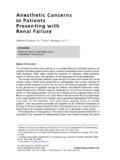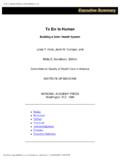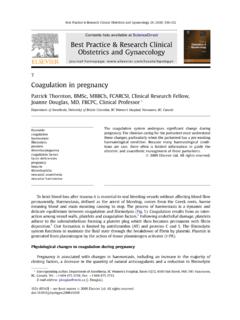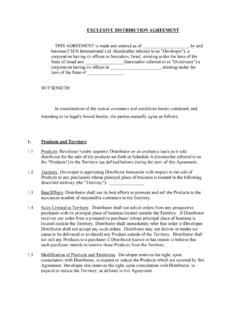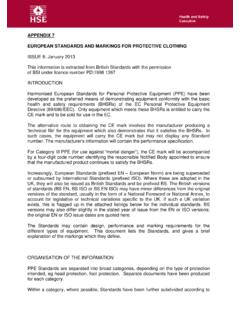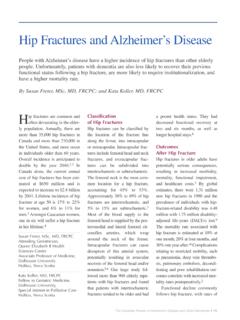Transcription of Regional anaesthesia and antithrombotic agents ...
1 Copyright european Society of Anaesthesiology. Unauthorized reproduction of this article is anaesthesia and antithrombotic agents :recommendations of the european Societyof AnaesthesiologyWiebke Gogarten, Erik Vandermeulen, Hugo Van Aken, Sibylle Kozek, Juan V. Llau and Charles M. SamamaBackground and objectivesPerforming neuraxial anaesthesiain patients receiving antithrombotic drugs is controversial due tothe increased risk of spinal epidural haematoma. Strictadherence to the recommended time intervals between theadministration of anticoagulants, neuraxial blockade and theremoval of catheters is thought to improve patient safety andreduce the risk of haematoma. Appropriate guidelines have beenprepared by a number of national societies ofanaesthesiologists, but they do not have universal introduction of new anticoagulants together with recentreports of stent thrombosis in patients with perioperativecessation of antiplatelet drugs have considerably broadened theissue and made revision necessary.
2 To overcome deficiencies incontent and applicability, the european Society ofAnaesthesiology has taken the initiative to provide current andcomprehensive guidelines for the continent as a review of the and conclusionsIn order to minimise bleedingcomplications during Regional anaesthetic techniques, careshould be taken to avoid traumatic puncture. If a bloody tapoccurs when intraoperative anticoagulation is planned,postponing surgery should be considered. Alternatively,catheters can be placed the night before surgery. Regionalanaesthesia in patients receiving full anticoagulation treatmentcontinues to be contraindicated. Catheter manipulation andremoval carry similar risks to insertion and the same criteriashould apply. Appropriate neurological monitoring is essentialduring the postoperative recovery period and following catheterremoval.
3 The final decision to perform Regional anaesthesia inpatients receiving drugs that affect haemostasis has to be takenafter careful assessment of individual risks and J Anaesthesiol2010;27:999 1015 Published online 1 October 2010 Keywords: apixaban, aspirin, bleeding, cilostazol, clopidogrel, dabigatran,epidural, fondaparinux, haematoma, heparin, hirudin, idrabiotaparinux,low-molecular-weight heparin, prasugrel, Regional anaesthesia ,rivaroxaban, spinal, ticagrelorAbbreviations:ACCP, American College of Chest Physicians; ACT,Activated Clotting Time; ADP, Adenosine Diphosphate; aPTT, ActivatedPartial Thromboplastin Time; ASRA, American Society of RegionalAnesthesia; DVT, Deep Venous Thrombosis; ECT, Ecarin Clotting Time; ESA, european Society of Anaesthesiology; ESC, european Society ofCardiology; FDA, US Food and Drug Administration; HIT, Heparin-InducedThrombocytopenia; INR, International Normalised Ratio; LMWH, Low-Molecular-Weight Heparin; NSAIDS, Non-Steroidal Anti-Inflammatory Drugs;PCC, Prothrombin Complex Concentrates; PF4, Platelet Factor 4; PDE,Phosphodiesterase; PT, Prothrombin Time; SSRI, selective serotonin uptakeinhibitor; UFH, Unfractionated Heparin.
4 VTE, Venous ThromboembolismBackgroundThe first national recommendations on neuraxial anaes-thesia and antithrombotic drugs were published bythe German Society for Anaesthesiology and IntensiveCare in 19971followed by the American Society ofRegional Anesthesia (ASRA) in 1998,2and Belgiananaesthesiologists in then new anti-coagulant agents have been introduced and moreinformation regarding the risk of neuraxial regionalanaesthesia with concurrent anticoagulation is addition, it has become clearthatifantiplateletdrugsare withheld after coronary stent implantation, therisk of adverse perioperative cardiovascular eventsincreases. Newer and more comprehensive recommen-dations are european Society of Anaesthesiology (ESA) working-party on Neuraxial anaesthesia and Anticoagulants,composed of academic physicians experienced in thistopic, has the aim of providing guidelines to assist Euro-pean anaesthesiologists in their daily clinical regard to perioperative cardiac risk, the same work-ing party has graded the level of recommendationsand the level of evidence for the european Society ofCardiology (ESC)-ESA guidelines, using the definitionsof the Committee for Practice Guidelines of the ESC(Table 1).
5 4 GUIDELINESThe editors would like to thank Alain Borgeat(Switzerland), Elisabeth Gaertner (France, ESA Scien-tific subcommittee 8), Daniela Filipescu (Romania,ESA Scientific subcommittee 6), Klaus Go rlinger(Germany, ESA Scientific subcommittee 6), (Netherlands,ESAS cientific subcommit-tee 8), Susan Mallett (UK, ESA Scientific subcommit-tee 6), and Andrew F. Smith (UK, Chair of the ESAG uidelines Committee) for their help in criticallyappraising the scientific content of this article. Potentialconflicts of interest of the assessors are stated in theAcknowledgements section at the end of this the Department of Anaesthesiology, Intensive Care and Pain Therapy,Harlaching Hospital, Municipal Hospitals of Munich, Munich, Germany (WG),Department of Anaesthesiology, University Hospitals, Katholieke Universiteit,Leuven, Leuven, Belgium (EV), Department of Anesthesiology and Intensive CareMedicine, University Hospital, Munster, Germany (WG, HVA), Department ofAnaesthesiology, Intensive Care and Pain Management, Vienna, MedicalUniversity, Vienna, Austria (SK), Department of Anaesthesiology and PostsurgicalCritical Care, Hospital Clinic Universiari, Valencia, Spain (JVL)
6 And Department ofAnaesthesiology and Intensive Care, Hotel-Dieu University Hospital, Paris (CMS),FranceCorrespondence to Wiebke Gogarten, MD, PhD, Department of Anaesthesiol-ogy, Intensive Care and Pain Therapy, Harlaching Hospital, Municipal Hospitals ofMunich, Munich, GermanyTel: +49 89 6210 2365; fax: +49 89 6210 3245;e-mail: 2010 Copyright european Society of european Society of Anaesthesiology. Unauthorized reproduction of this article is to the rarity of spinal epidural haematoma, recom-mendations regarding neuraxial Regional anaesthetic pro-cedures with concurrent thromboprophylaxis, are notbased on prospective randomised studies, but rather oncase reports and expert opinion. The latter is based mainlyon knowledge of the pharmacokinetics of the individualagents concerned.
7 A rule of thumb adopted by mostnational societies puts the time interval between cessationof medication and neuraxial blockade at two times theelimination half-life of the drug. This approach hasrecently been recommended by decision for or against Regional anaesthesia alwaysrequires a careful risk benefit analysis, noting any historyof bleeding, followed by a physical examination lookingfor signs of increased bleeding tendency, for examplepetechiae or haematoma6(Class I, level A). Laboratorytests, if indicated at all, should be appropriate to theindividual (Class I, level A). Routine laboratory investi-gations do not always detect impaired coagulation. Theperioperative cessation of anticoagulant drugs to improvethe safety of neuraxial block needs to be critically eval-uated.
8 An alternative anaesthetic technique should beused if it is judged that the administration of the antic-oagulant must not be interrupted (Class IIa, level C).Finally, the present guidelines are not intended to bypassclinical judgment. When the anaesthesiologist decidesnot to comply with these guidelines, the reasons shouldbe noted in the patient s of spinal epidural haematomaSpinal epidural haematoma often occur spontaneously,without any temporal relationship with neuraxial anaes-thesia. The absolute risk of spinal bleeding duringconcurrent thromboprophylaxis is not known, andfollowing neuraxial blockade, events are too rare tostudy in a randomised clinical trial. Relatively recentcase series suggest that the risk of spinal epidural haemor-rhage is possibly much higher than was 13 After enoxaparin 30 mg twice daily was introduced forthromboprophylaxis in the United States an alarmingnumber of spinal epidural haematoma, some with per-manent paraplegia, were reported,7triggering a warningfrom the US Food and Drug Administration (FDA).
9 Collation of these cases in the USA allowed the risk ofspinal epidural haematoma during concurrent adminis-tration of low-molecular-weight heparins (LMWHs) to becalculated at 1 : 40 800 for spinal anaesthesia , 1 : 6600 forsingle-shot epidural anaesthesia , and 1 : 3100 for epiduralcatheter appears to be a relativelyhigh incidence of bleeding was attributed to the twicedaily administration of LMWH, and the lack of recom-mendations at that time regarding time intervals betweenneuraxial puncture or catheter removal and thrombopro-phylaxis. The response in the USA has been to introducerecommendations that are stricter than those in place inEurope, proposing avoidance of LMWH the entire timeepidural catheters are in place. This does not adequatelytake into account the increased perioperative risk ofvenous thromboembolism (VTE).
10 14In Europe, the wide-spread adoption of a single daily dose of enoxaparin 40 mgproduced a lower incidence of complications. A retro-spective analysis in Sweden found the risk was 1 : 156 000after spinal anaesthesia and 1 : 18 000 after epiduralanaesthesia, with bleeding occurring more rarely in obste-trics (1 : 200 000) than in female orthopaedic patientsundergoing knee arthroplasty (1 : 3600).8 Risk factorsfor spinal haematoma after neuraxial Regional anaesthesiawere identified as lack of guidelines, administration ofantithrombotic agents , female sex, and difficult punctu-res. Subsequent reports from various countries indicatethat spinal epidural haematoma after neuraxial blockadeoccurs in 1 : 2700 to 1 : 19 505 patients,9 12with one reportindicating that haematoma may be more common afterlumbar (1 : 1341) compared to thoracic epidural anaes-thesia (0 : 10 199).

